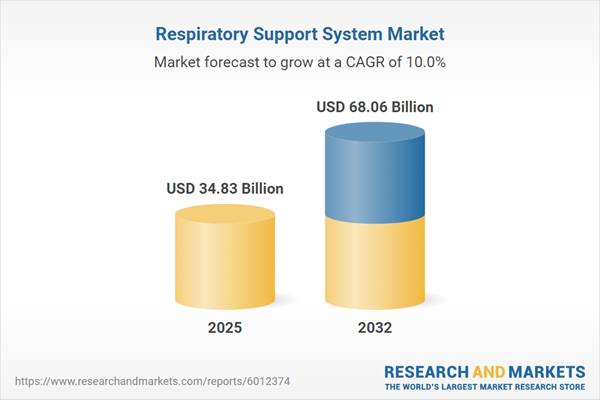Speak directly to the analyst to clarify any post sales queries you may have.
The respiratory support system market is undergoing a fundamental transformation, with healthcare providers adopting integrated technologies and adaptive care models to efficiently serve the evolving needs of diverse patient segments. This shift is driving operational efficiency and adaptability across care settings.
Market Snapshot: Respiratory Support System Market Performance and Growth
In 2024, the global respiratory support system market recorded a value of USD 31.71 billion and is anticipated to reach USD 34.83 billion in 2025, reflecting a compound annual growth rate (CAGR) of 10.01%. Forward projections indicate the market will achieve USD 68.06 billion by 2032.
This growth is fueled by increasing rates of respiratory diseases and improved access to advanced care options. Manufacturers are actively upgrading products and forming strategic partnerships to stay ahead in a competitive landscape shaped by demographic shifts. Navigating varying regional regulations and capitalizing on digital infrastructure advancements are vital for maintaining an edge in established and emerging markets.Scope & Segmentation: Strategic Market Dimensions
- Product Types: High-flow oxygen therapy systems, ventilators, masks, nasal cannulas, and concentrators remain integral across emergency departments, inpatient wards, and homecare, delivering adaptable solutions for acute and chronic patient cases.
- Modes of Delivery: Invasive and noninvasive systems, including applications in anesthesia and intensive care, support personalized interventions that align with changing patient acuity and clinical demands.
- Clinical Applications: Devices address both short-term and long-term needs, managing syndromes such as respiratory distress, COPD, and sleep apnea, often enabled with integrated monitoring to optimize patient outcomes in real time.
- Portability: Portable support systems enhance mobility and flexibility in emergency and home-based environments, while stationary units remain central for long-term care and specialized medical centers.
- End Users: Hospitals, homecare providers, and ambulatory clinics employ IT-compatible respiratory solutions to streamline workflows and enable scalable, flexible service models.
- Regional Coverage: The Americas, Europe, Middle East and Africa, and Asia-Pacific regions each exhibit unique regulatory trends, digital health growth, and evolving clinical practices, requiring localized go-to-market strategies and compliance.
- Leading Companies Profiled: Key market innovators include Koninklijke Philips N.V., ResMed Inc., GE HealthCare Technologies Inc., Medtronic plc, Drägerwerk AG & Co. KGaA, Becton Dickinson and Company, Smiths Group plc, Mindray Medical International Limited, Fisher & Paykel Healthcare Corporation Limited, Nihon Kohden Corporation, Baxter International Inc., and Intersurgical Ltd., all known for driving technological advancement and responding to sector changes.
Key Takeaways: Insights for Senior Decision-Makers
- Care delivery is increasingly decentralized, with remote and community-based respiratory solutions aligning with demographic trends and enabling care closer to the patient’s environment.
- Connected digital technologies are enhancing enterprise transparency by simplifying workflow processes and enabling efficient clinical data management at scale.
- Telehealth solutions and remote monitoring tools are strengthening continuity and responsiveness of respiratory care in multiple clinical and home-based contexts.
- Collaboration between manufacturers, technology vendors, and clinical organizations is accelerating product development cycles and reinforcing regulatory compliance.
- Regionally distinct reimbursement models and clinical protocols are prompting businesses to adopt versatile delivery structures and compliance plans that match local policies.
- The effectiveness of technology adoption is largely determined by the maturity of digital health infrastructure, underscoring the need for market strategies attuned to regional readiness and growth.
Tariff Impact: Addressing Global Trade and Supply Chain Challenges
Recent United States tariffs on imported respiratory support equipment require enterprises to reevaluate sourcing and procurement operations. Building diversified supplier networks and optimizing purchasing workflows are becoming essential to maintain stable access to key products as international regulations continue to evolve.
Methodology & Data Sources
Research combines direct interviews with senior industry stakeholders, developers, and procurement teams, alongside reviews of clinical, technical, and operational datasets. This approach ensures robust, up-to-date analysis of key market drivers, regulatory direction, and emerging operational patterns.
Why This Report Matters
- Senior leaders can allocate resources optimally, refine product and service portfolios, and address regulatory requirements with segmentation and actionable insights tailored to organizational priorities.
- The analysis supports organizational preparedness for ongoing changes in procurement and technology, elevating resilience in uncertain and shifting markets.
- Decision-makers gain actionable regional and segment-level intelligence to drive effective strategy and guide expansion in advanced respiratory care services.
Conclusion
With targeted intelligence and strategic market perspective, organizations are better prepared to strengthen resilience and adapt to ongoing changes in the respiratory support system market.
Additional Product Information:
- Purchase of this report includes 1 year online access with quarterly updates.
- This report can be updated on request. Please contact our Customer Experience team using the Ask a Question widget on our website.
Table of Contents
3. Executive Summary
4. Market Overview
7. Cumulative Impact of Artificial Intelligence 2025
Companies Mentioned
The companies profiled in this Respiratory Support System market report include:- Koninklijke Philips N.V.
- ResMed Inc.
- GE HealthCare Technologies Inc.
- Medtronic plc
- Drägerwerk AG & Co. KGaA
- Becton Dickinson and Company
- Smiths Group plc
- Mindray Medical International Limited
- Fisher & Paykel Healthcare Corporation Limited
- Nihon Kohden Corporation
- Baxter International, Inc
- Intersurgical Ltd
Table Information
| Report Attribute | Details |
|---|---|
| No. of Pages | 191 |
| Published | October 2025 |
| Forecast Period | 2025 - 2032 |
| Estimated Market Value ( USD | $ 34.83 Billion |
| Forecasted Market Value ( USD | $ 68.06 Billion |
| Compound Annual Growth Rate | 10.0% |
| Regions Covered | Global |
| No. of Companies Mentioned | 13 |









